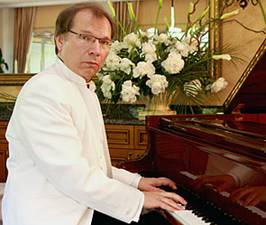Avales
 |
|
Yuri Rozum
A soloist of Moscow State Academic Philharmonic Society
A full member of Russian National Academy of Natural Science
The president of Yuri Rozum International Charitable Foundation
A national artist of Russia
http://en.wikipedia.org/wiki/Yuri_Rozum
First time I learned about 'Soft way to Mozart' was in April of 2006. I've always been interested in the latest inventions in the field of music education. I think that the primary music education needs reform. It is far from providing successful music learning for the majority of children by losing students in elementary classes of music schools. We are not only losing future musicians, but, above all, we are losing educated music listeners. In addition, what a loss for those people for whom the beautiful world of music remains unknown.
After I learned the key features of the 'Soft Mozart' computer system, I had a chance to see how this method worked with my 9-year-old daughter. Previously, she didn't want to hear about music lessons with the traditional approach. However, now she is learning piano successfully and with great pleasure using this system.
I want to say the following:
- The program 'Soft Mozart' does not conflict with classical approaches of music learning. In fact, this program is a 'missing link' of traditional music education filling the lack of visual support during the first steps of acquaintance with the space of piano keys and musical notation.
- The program 'Soft Mozart' brilliantly uses the computer for creating the interactive learning of music as a language. The student is able to play a musical composition with one hand while listening to the part of the other hand being played automatically. Then, the student is able not only to see one's own mistakes in the performance of a musical score, but make corrections without the teacher's help. Finally, the student is able to memorize easily a music piece without anybody's assistance while still controlling its correctness. The student starts fluent music reading from the first lessons. This is far from a full list of all advantages and benefits that the system can give to every beginner.
- This program is a break-through approach because with its help any person, regardless of his or her talent, can learn how to read the music score and play the piano (or other keyboard instruments) with both hands and all ten fingers. This is important for development of music ear, memory, and for the sake of pleasure to learn music.
- The turned sideways 'primary presentation' of a musical score with color-coded pictures allow students to cope with reading and coordination problems in balance. This is an original 'ABC book' of music.
- The gradual transformation of a musical score from the 'primary presentation' to the traditional presentation allows any student to understand the musical notation easier and faster.
Any use of 'Soft Mozart' system can substantially relieve the work of music teachers during the classes of piano, theory, or solfeggio. Because the computer takes care of the routine development of basic skills, it spares the teacher's time and energy for more complicated professional and artistic tasks.
I recommend using this system not only for music institutions, but also in daycare centers, schools and any organizations that are related to the upbringing and cultural education of children. In addition, this system provides inestimable advantages for home music practice.
 |
|
Victoria Lopez Meseguer
Piano Teacher and Vicedean of the Conservatorio Profesional de Musica Joaquin
Turina de Madrid Calle Serrano
226 Duplicado Madrid 28016 Spain
This email address is being protected from spambots. You need JavaScript enabled to view it.
To whom it may concern:
I write this letter to strongly recommend SoftMozart as a wonderful method for teaching music. And I speak of music and not only of piano because Softmozart helps setting the foundations of not only piano fundamentals but also ear training, internal rhythm, harmony and music memory. I find it my obligation to be alert of new possibilities for my piano students. I teach all levels but I am specially concerned about the beginning of education. First, because I am convinced that the younger the student, the better the teacher should be. Not only in the psychological approach but also because of the fact that one needs to have the final goals so clearly as to not introduce anything that could be a learning burden for a student in the future.After all, music learning is a spiral method. We teach the same concepts again and again and the only difference is the context, the music piece that the student plays. On the other hand, there are many methods that captivate the student at the beginning but makes them face a dessert after a year or two. I am thinking of teaching methods that provide the student with no reading grounds. Most of these students quit when they find themselves having to read what they think they can play by imitation. I also find my obligation to dive into the real XXI century, meaning that the students of today deserve the possibilities that the rest of the curricula offer to them: technology. I was startled to know the results of the investigations of Rauschen in 1997 where he compared the results in spatial-temporal outcomes of a group of children who had taken piano lessons, a group of children that had taken computer lessons and a group of children who had taken no special lessons appart from traditional school subjects.The study found that those receiving piano lessons indeed scored 34 percent higher on tests measuring spatial-temporal ability. Then followed the children who had received computer training. Well, SoftMozart combines these two trainings. To start with, children just stick to the piano no matter how young. I have seen three year old children waving goodbye to their parents without even looking at them as they left and begging for more after their lesson. And this is a very good start for any teacher
In respect to the advantages of the method I would like to highlight:
- It doesn’t interfere at all with my traditional teaching. The teacher has a reason to exist with constant indications about fingering, hand position and relating concepts from one piece to another.
- The chosen pieces are also "traditional". Bastien, for example, is one of the most famous methods in Spanish Conservatories.
- Fruit Lines and Guess Note are two games that also help train absolute ear. After more than twenty years of teaching I have found no better method for this. The child constantly listens to the sound of a note with no boring sensation because he thinks he is only playing with a video console game when in fact he is receiving constant listen-recognise feedback about absolute pitch.
Some children just respond to sound. To be able to recognise these children at so early stages is an invaluable tool for a teacher. Any other method to work these that I can think of would involve an active respond from the child, and we all know that the shiest children can be the best hidden artists. - Note duration makes rhythm not only a mental process from the mathematical point of view but also a fast muscular responding process, as it should eventually become in the future for any pianist. The child thinks and feels the rhythm and it is hard to tell what comes first.
- Small children can spend years in music movement lessons before starting piano in traditional teaching. Now I see no reason why they should wait for so long before playing piano, provided the piano keys weight is appropiate for their muscles.
- With respect to Gentle Piano these are the rest of the advantages I see:
- The vertical disposition of the staves compared to the horizontal simply mean that what is on the right is on the right and what is on the left is on the left. This sounds absurd but the fact is that with traditional teaching a piano students needs to face orientation indications that contradict natural laws. Some parents are concerned with this fact (so what will happen when he faces a "normal score"?). I just press a key on the computer and the students faces the "normal score". And the student just plays because he also recognises his favourite toy if we turn it around. The important fact is that he has understood in a natural way the direction of the music on the score and the direction of the same notes on the piano.
- Some traditional teachers say "ok, but art has nothing to do with this". My answer is always the same one. Your first obligation is to teach the student how to read and now the linguistics. Your second obligation could be letting him read a best seller or take his hand and dive him into Shakespeare. Well, I don’t know of any Language teacher who wouldn’t appreciate all this help in teaching their students how to read. This can only result in having spare time for the "artistic process".
- The evaluating process is an instantaneus thing. The competition is not with the teacher. The teacher doesn’t correct things as "not a do or a fa but a mi". The teacher can teach and correct other more important things and doesn’t need to accompany with words every sound of the piano. After all we keep telling our students that music and silence go together. The fact that the teacher is in your team and that the competition is IN the computer, is another pedagogical approach that I find invaluable.
- Group individual teaching. That is another advantage. I can switch from one to another many times in a very short lapsus of time. This allows me to make a correction without directing it to the child that needs it. I speak aloud and all of them listen to it but the one that needs it is the one that understands it better.
- The fact that the creators of this method keep upgrading the software and are always ready to listen to suggestions and keep in touch with the teachers who use it is really important for me. I wish I could say the same thing for other creators of software that I use for only Solfegge training. I have found myself using the songs of SoftMozart in the traditional layout for solfegge singing. The child first reads and sings the piece with the solfegge notes and then learns it on the piano.
I can only recommend SoftMozart for any teacher willing to have an invaluable aid in teaching what for so many people is the reason to not have continued with piano education: boring approaches or just the intrinsic difficulty in beginning of the learning process.